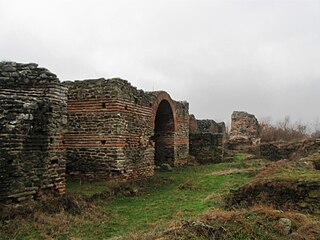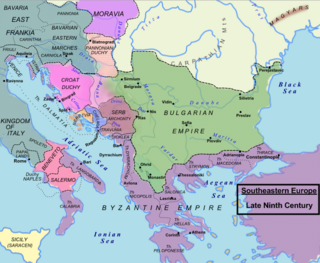 W
WArchbishopric of Justiniana Prima was an Eastern Christian autonomous Archbishopric with see in the city of Justiniana Prima and jurisdiction over the Late Roman Diocese of Dacia in central parts of the Southeastern Europe.
 W
WThe Battles of Viminacium were a series of three battles fought against the Avars by the East Roman (Byzantine) Empire. They were decisive Roman successes, which were followed by an invasion of Pannonia.
 W
WBregovina is a village in the municipality of Prokuplje, Serbia. According to the 2002 census, the village has a population of 70 people.
 W
WJustiniana Prima was a Byzantine city that existed from 535 to 615, and currently an archaeological site, known as or Caričin Grad, near modern Lebane in southern Serbia. It was founded by Emperor Justinian I (527-565) and served as the metropolitan seat of the Archbishopric of Justiniana Prima, that had jurisdiction over the provinces of the Diocese of Dacia.
 W
WIn 566, Lombard king Alboin concluded a treaty with the Pannonian Avars, to whom he promised the Gepids' land if they defeated them. The Gepids were destroyed by the Avars and Lombards in 567. Gepid King Cunimund was killed by Alboin himself. The Avars subsequently occupied "Gepidia", forming the Avar Khaganate. The Byzantine Emperor intervened and took control of Sirmium, also giving refuge to Gepid leader Usdibad, although the rest of Gepidia was taken by the Avars. Gepid military strength was significantly reduced; according to H. Schutz (2001) many of them joined Lombard ranks, while the rest took to Constantinople. According to R. Collins (2010) the remnants were absorbed either by the Avars or Lombards. Although later Lombard sources claim they had a central role in this war, it is clear from contemporary Byzantine sources that the Avars had the principal role. The Gepids disappeared and the Avars took their place as a Byzantine threat. The Lombards disliked their new neighbours and decided to leave for Italy, forming the Kingdom of the Lombards.
 W
WPannonia was a Byzantine province, which existed in present-day Syrmia region of Serbia in the 6th century. Its capital was Sirmium.
 W
WThe Principality of Serbia was one of the early medieval states of the Serbs, located in western regions of Southeastern Europe. It existed from the 8th century up to c. 969-971 and was ruled by the Vlastimirović dynasty. Its first ruler known by name was Višeslav who started ruling around 780. While by that time, starting from the year 681, the Bulgarian state had taken the lands to the east, preparing to conquer Serbia. Vlastimir defeated the Bulgarian army in a three-year-war (839–842), and the two powers lived in peace for some decades. Vlastimir's three sons succeeded in ruling Serbia together, although not for long; Serbia became a key part in the power struggle between the Byzantines and Bulgarians, which also resulted in major dynastic wars for a period of three decades. Central parts of the principality were shortly occupied by the Bulgarian army for three years (924–927), until Serbian prince Časlav was able to liberate the land and unite several Serbian regions, becoming the most powerful ruler of the Vlastimirović dynasty. An important process during this period was the Christianization of the Serbs, the establishment of Christianity as state-religion c. 869, and the founding of the first Serbian eparchy (diocese), the Eparchy of Ras. The principality was annexed by the Byzantines in c. 969-971 and ruled as the Catepanate of Ras. The main information of the history of the principality and Vlastimirović dynasty are recorded in the contemporary historical work De Administrando Imperio.
 W
WThe Siege of Sirmium in 580–582 was a decisive event in the history of the Balkans. The fall of the city to the Avars deprived the Byzantine Empire of its major stronghold on the northwestern Danube, opening the path for devastating incursions by the Avars and their Slavic allies into the Balkans.